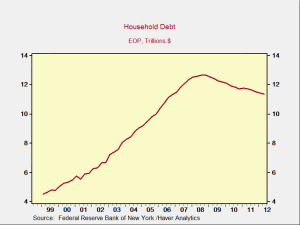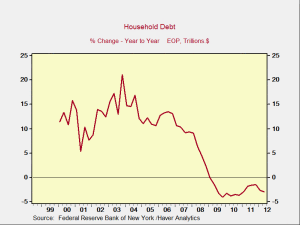We have some more good charts from Pete Essele, data maven in our Asset Management and Research groups, this time about household debt and how we are paying (or writing) it off.
The first chart illustrates the debt service level, as follows:
As you can see, debt service as a percentage of income has declined about 25 percent since its peak. This is a big improvement, and the fact that we are close to 30-year lows suggests that consumers have a lot of room to start borrowing and spending again.
Being a skeptical person, I sent Pete an e-mail saying, essentially, okay, but how much of this is just due to low rates? Has the actual debt declined—or just the payments? To which he responded with the following:
Household debt has indeed declined, albeit by a much lower percentage. So we do have an absolute decline in debt, but a large part of that decline can be attributed to lower rates, suggesting that the room to spend again is much more limited than the debt service figures suggest.
Pete also sent the following chart on trends:
Looking at this chart, again we can see that although consumers may be able to borrow more based on interest rates, they certainly are not doing so. In fact, net borrowing has been negative since the crisis and shows no sign of changing anytime soon.
Eventually, of course, this will be good news. Consumer borrowing will enhance demand and juice up growth. For the moment, though, the ongoing de-levering will continue to depress demand below what it would otherwise be—but it will help to restore economic health and support tomorrow’s growth. This is a necessary step in the healing process and nothing to complain about.


 Print
Print





